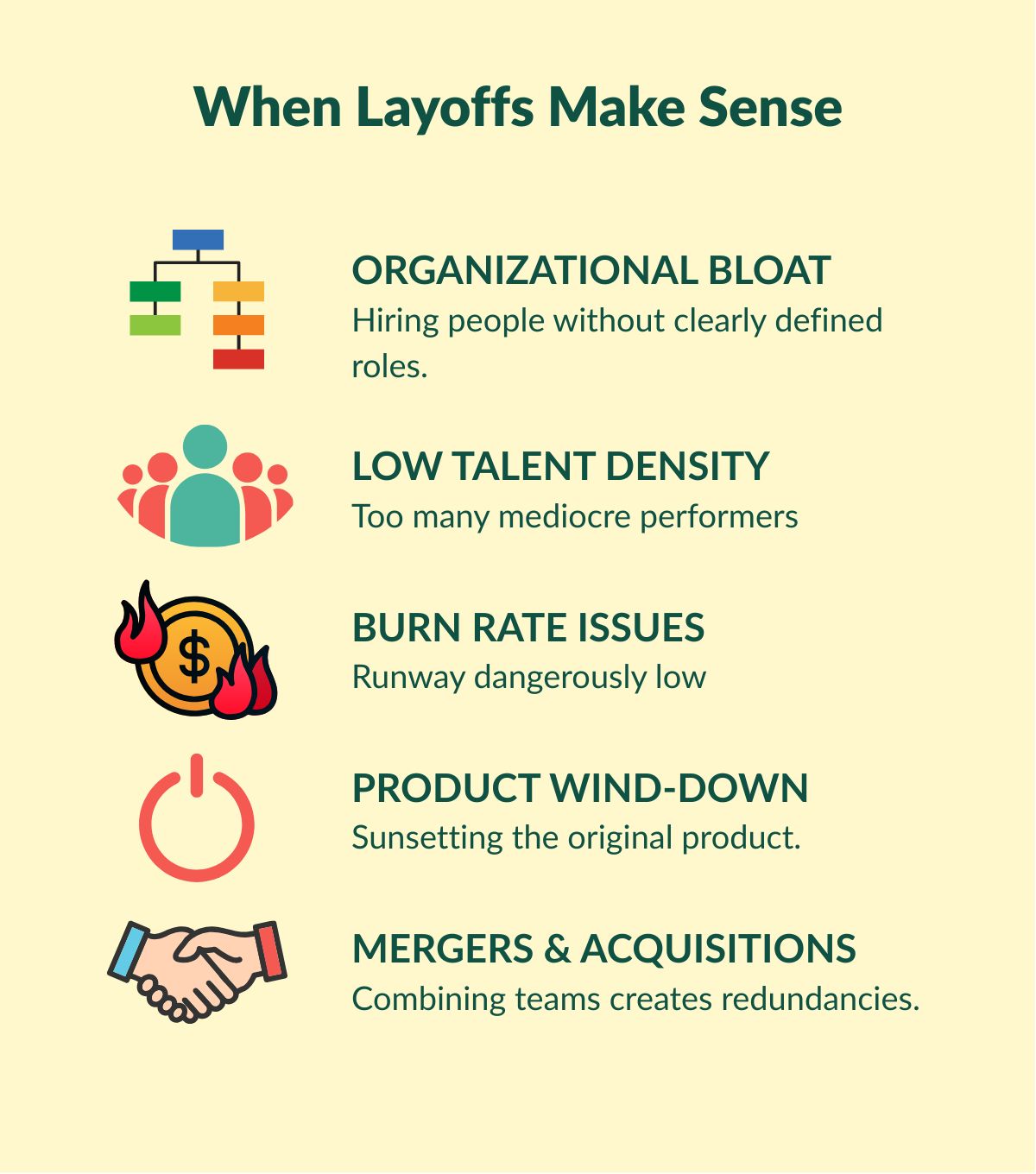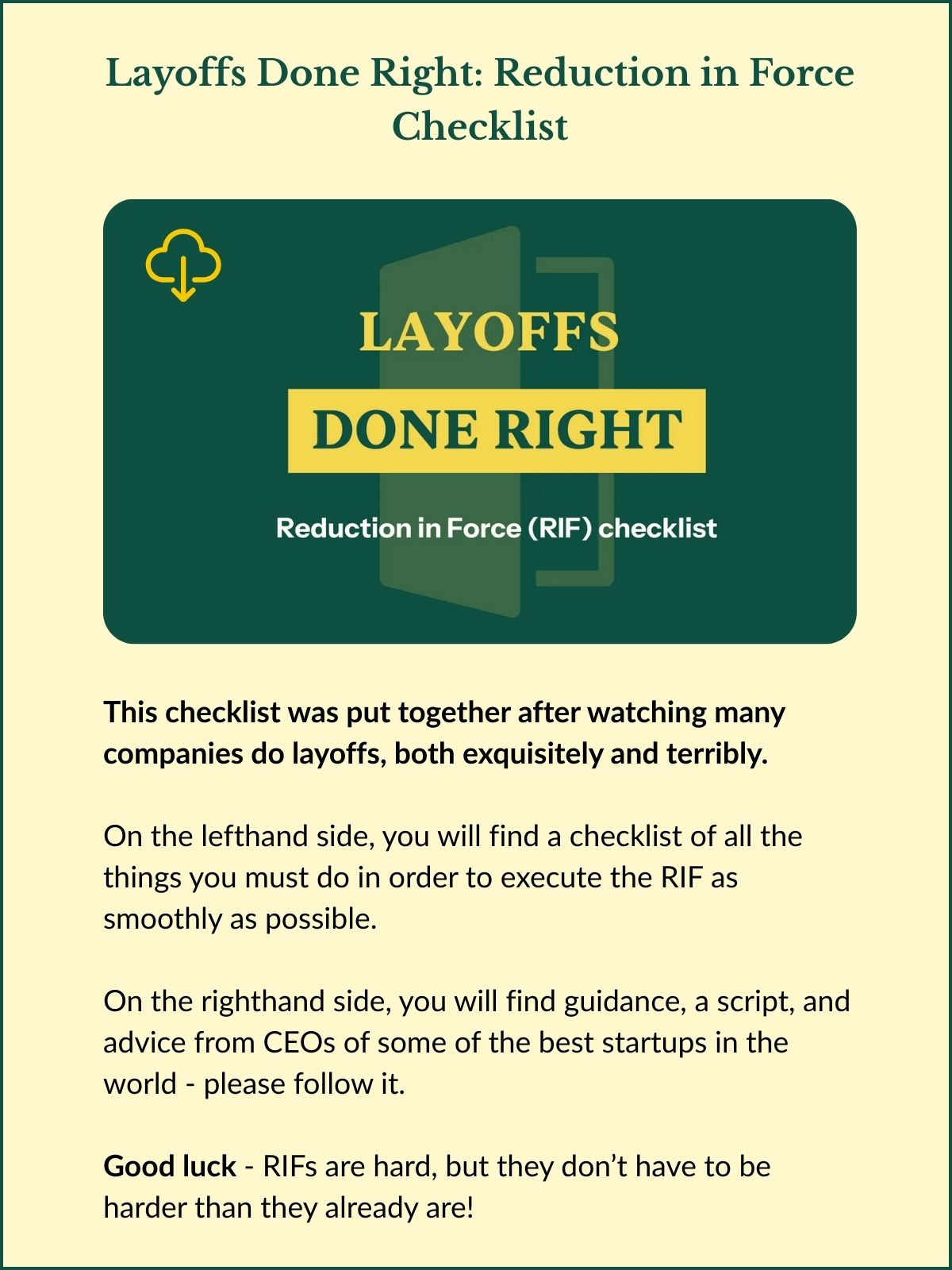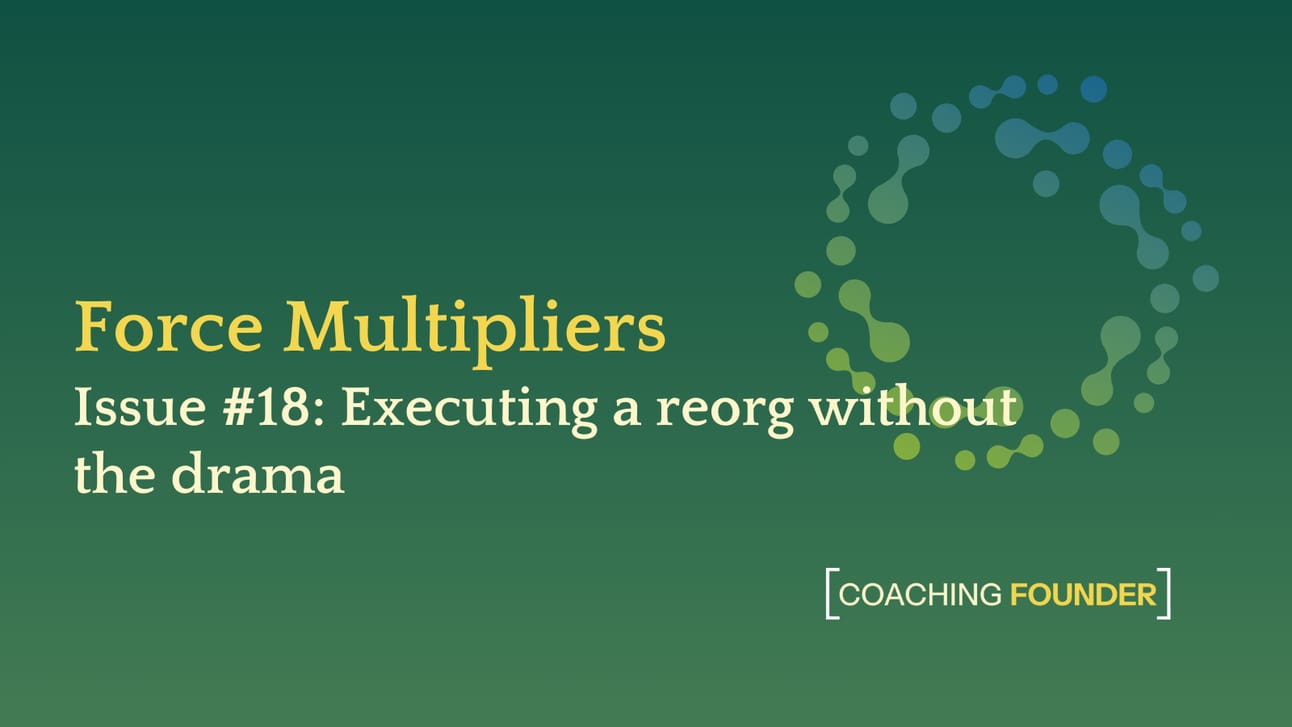- Force Multipliers
- Posts
- Layoffs Done Right
Layoffs Done Right
When and how to perform layoffs with minimal chaos and demoralization. (Free template included!)
Hi! Welcome to another issue of Force Multipliers, your weekly briefing from Regina Gerbeaux, where Silicon Valley's behind-the-scenes operators get battle-tested frameworks for their toughest challenges, from putting out chaotic fires to managing strong personalities.
Dear Regina,
I've been tasked with leading a layoff at our company, and I'm feeling completely overwhelmed. Our CEO has decided this is happening (he's known for making decisions that are non-negotiable), and while I understand the business rationale, this is my first time executing something of this magnitude.
I'm stressed because I know this is probably the most important workstream I'll own at our company. I've laid out a plan and done research, but I've never actually done this before.
I'm also struggling with how to maintain relationships. I have close friendships with people who might be impacted, which makes me feel anxious and fake when I'm around them. I worry that after this, people won't trust me or will look at me differently.
The emotional weight is heavy too - I feel conflicted about decisions that affect people I care about, and frustrated that I can't change the overall decision, only influence how we execute it.
I want to do right by everyone involved while still being effective in my role. How do I navigate all of this?
(VP of Operations, Series C, ~80 people, ~$100M raised)
Dear Operator,
If you're facing layoffs, you're probably feeling a mix of emotions right now. Whether you're a first-time CEO or the operator tasked with execution, I understand the weight of this responsibility.
Truth is, companies rarely regret doing layoffs - they usually regret not doing them sooner. Fear often holds us back: fear of demoralizing the team, fear of investor perception, fear of signaling failure, fear of burnout for remaining staff.
In other words, I get it. And if you’re struggling, congratulations - you’re not a sociopath! You care about people.
Below is the playbook on how to execute layoffs without being a jackass. 👇
The Playbook on Doing Layoffs Right
Step 1: Make sure it is the right time.
If you’re reading this playbook, maybe you’ve already decided to do a layoff. But maybe you’ve heard your CEO float the idea and as an operator you know you’ll be tasked with executing it - or, you aren’t really sure when a layoff makes sense.
Either way, here’s more guidance on knowing when it’s the right time to do one.
Based on my years of working with startups of all shapes and sizes, here are the five common scenarios I see when layoffs make sense:

Organizational Bloat.
Remember the gravy train of COVID when companies were flush with cash and hiring like crazy? Many added people without clearly defined roles, just throwing bodies at problems. If you can't clearly articulate what each person does, you likely have bloat.
Low Talent Density.
If your organization is weighed down with B and C players, it's time to consider restructuring. A smaller team of exceptional A players can accomplish far more than a larger team of mediocre performers. The best part is, you can redirect those savings to pay your top performers even better, creating a virtuous cycle.
Burn Rate Issues.
This is my least favorite reason for layoffs. If you're only cutting because runway is dangerously low, you've waited too long. Ideally, you should be intentional about hiring from the start so everyone on your team is truly necessary.
Product Wind-Down.
Early-stage companies sometimes pivot from their initial product to something that shows more promise. As you sunset the original product, you may need to let go of people who were primarily working on it.
Mergers & Acquisitions.
When combining teams creates redundancies (like having four finance people where you only need two), layoffs often follow.
⚠️ WARNING!
If any of these scenarios are applicable to you, it’s a good sign it’s time to do a RIF.
Step 2: Create a clear layoff philosophy and evaluation criteria.
Next, you have to come up with a layoff philosophy.
A layoff philosophy is simply the framework you’ll use to decide who makes the cut and who you’ll part ways with.
To come up with your philosophy, decide why you’re cutting. Is it to…
Ensure survival of the company?
Improve talent density?
Prepare for an acquisition?
That’s why this is Step 2 - the first step, determining the reason for your layoff, will help you decide the motivation or “why” behind letting people go.
The “why” will then help determine the criteria you use to evaluate who to keep.
This list might include:
Performance (especially important for talent density issues)
Role criticality (how essential is their function to the company's future?)
Cultural fit (even top performers who don't align with company values can be destructive)
The one I have to highlight in particular is cultural fit. Too many people retain brilliant jerks, or people who otherwise aren’t a good fit for the new era of the culture you’re trying to create post-layoff.
👉 Fun fact! A new piece about when and how to break up with Brilliant Jerks will be coming out next month (August 17), so make sure you’re subscribed so you don’t miss that one. 😉
🫵 Consider this your callout: make sure you account for cultural fit, not just raw performance.
Step 3: Decide who you’re cutting.
Based on the criteria informed by the layoff philosophy in the previous step, you’re now ready to decide who to say goodbye to.
To execute this layoff, DO NOT involve too many cooks in the kitchen. The more people who know, the more likely it will get out that you are doing layoffs. Your productivity will tank, and panic will ensue. It is not a good idea.
Instead, you’ll want to create a very short list of people involved in executing this layoff. This usually includes:
CEO (for obvious reasons)
Operator (a Chief of staff, COO, or Head of Operations, to execute)
Executive Assistant to CEO (for logistical support)
HR / Legal representative (to make sure it’s done properly and by the books)
Essential department heads (to know who on the team they will have to cut)
Make a spreadsheet of remaining employees. Evaluate each employee on the criteria you’ve determined. Your department heads should be 100% on the same page as the CEO for what “cultural fit” really means for this new era of the company, to ensure fairness and unbiased evaluation.
💭 Question: Have you considered cutting at the top? 🤔
I’ve seen some companies assume immediately that the only layers that should get impacted during layoffs are middle management and below. This is a mistake! While doing layoffs, no one is immune, not even leadership.
Nothing damages morale more than leadership going unscathed while individual contributors bear the brunt. If your layoffs only impact lower-level employees, it looks like management doesn't care about "the little guy."
Therefore, truly evaluate who's adding value regardless of title.
Step 4: Plan a reorg as part of the layoffs if needed.
After layoffs, it might be necessary to re-shuffle around the org chart in case any ICs no longer have their managers, or if teams have to be consolidated for efficiency purposes.
As a result, decide what the org chart should look like. That way, you have zero ambiguity in reporting structure and who is responsible for what.
I’ve already written this piece on how to execute a reorg with minimal drama, which you can find here.
Step 5: Execute quickly.
So far, you’ve…
Decided it’s time to do layoffs
Determined the philosophy and criteria to do so
Figured out who is going to be involved and decided who to cut
Decided what the org chart will look like with remaining employees
Now you’re ready to move forward.
It is of utmost importance to act quickly. The longer you wait between decision and execution, the more likely information leaks and anxiety spreads.
I've seen layoffs executed well in as little as two weeks - including creating the list, finalizing plans, preparing severance/benefits information, and communicating with affected employees.
🗒️ Note on RIFs due to M&As:
For M&As specifically, complete layoffs before integrating teams.
This ensures the newly combined organization starts fresh, without the cloud of impending cuts hanging over everyone.
It will give you a fresh slate, and you’ll be able to hold a blended team offsite shortly after to help solidify the M&A.
BONUS: Free RIF checklist template ✅
Did you know? I have a totally free RIF checklist template that is available for free download on Notion here.
This checklist was made with the inputs of some of the biggest and most successful startup CEOs in Silicon Valley. In an off-the-record discussion, they shared some of their greatest advice and tips, any regrets they had, and answered questions from other CEOs in similar positions as them.
This checklist was created based on exactly those learnings. It has been battle-tested by many companies, from earlier-stage startups to growth stage companies will hundreds of millions in the bank. It works every time.

When done with care and clarity, layoffs can set your company on a healthier path forward - with the right team to take you there.
Good luck, and know that just because things are hard, doesn’t mean you shouldn’t do them.
Until next time,

Resources Mentioned 📌
Executing a Reorg Without the Drama | Force Multipliers, Issue #18
Layoffs Done Right: RIF Checklist | Coaching Founder
Was this newsletter forwarded to you? Are you here for the first time? If so, remember to subscribe below…
Want more operational content?
Check out Coaching Founder for over a dozen free, downloadable Notion templates to use at your company, and tons of write-ups on how to level up your execs, your teams, and yourself.
About Regina Gerbeaux
 | Regina Gerbeaux was the first Chief of Staff to an executive coach who worked with Silicon Valley’s most successful entrepreneurs, including Brian Armstrong (Coinbase), Naval Ravikant (AngelList), Sam Altman (OpenAI / Y Combinator), and Alexandr Wang (Scale). |
Shortly after her role as Chief of Staff, then COO, she opened her own coaching practice, Coaching Founder, and has worked with outrageously talented operators on teams like Delphi AI, dYdX, Astronomer, Fanatics Live, and many more companies backed by funds like Sequoia and Andreessen Horowitz.
Her open-sourced write-ups on Operational Excellence and how to run a scaling company can be found here and her templates can be found here.
She lives in the Pacific Northwest with her partner Lucas and dog Leia, and can be found frequenting 6:00AM Orangetheory classes or hiking trails nearby.


Reply